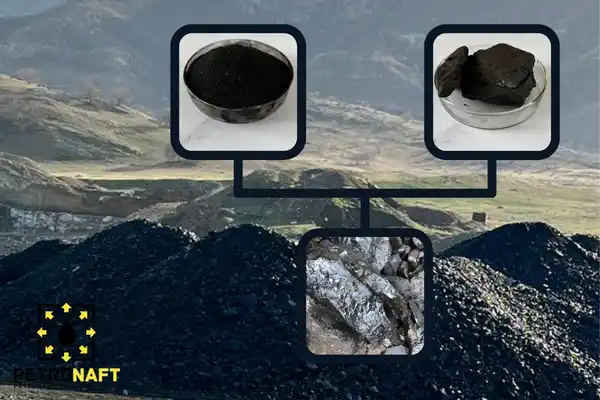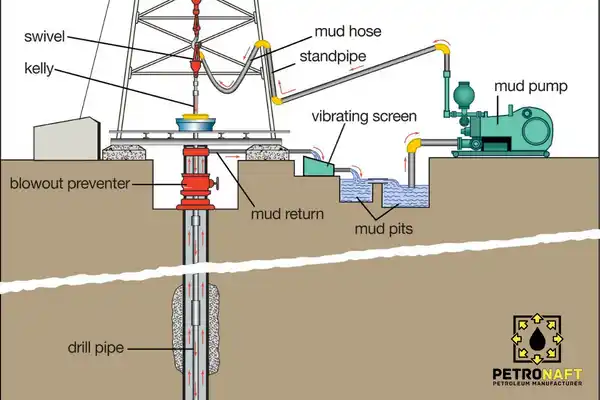GILSONITE FOR OIL AND GAS DRILLING
Gilsonite for oil and gas drilling has been shown to be effective under pressure and provides advantages not found in cementing or drilling fluids. Gilsonite improves the performance of cementing and drilling fluids in ways that no other single additive can match. This is made possible by its exceptional combination of strength, flexibility, bonding, and high-temperature capabilities. This additive is a naturally occurring hydrocarbon resin. It is quite versatile and can be used for a variety of purposes. In comparison to synthetic materials, gilsonite has significant advantages in terms of health, safety, and the environment (HSE). Gilsonite is classified as non-toxic, non-carcinogenic, and non-mutagenic by the OSHA Material Safety Data Sheets.
GILSONITE FOR CEMENTING
Gilsonite is a mineral that is utilized in the cementing of oil wells as well as drilling mud fluids. Gilsonite is a frequent component in oil-based drilling muds used for drilling in shales and other difficult geological formations. Gilsonite is available in a range of softening points and particle sizes. Gilsonite that has undergone specialist processing is mixed with water-based drilling fluids. This reduces hole washout by hardening tough shales and preventing extremely permeable sands while simultaneously minimizing torque and drag. When used with oil well cement, gilsonite may reduce slurry weight while cementing compressive strength. It may also be used as a bridging and plugging agent to conceal fractures in weak formations while cement is being placed. The use of gilsonite in oil and gas well cementing is a well-established technology. For many years, cement-water slurries, with or without different additives, have been utilized in cementing operations that are performed from time to time throughout the drilling phase of a well’s productive life. These processes were performed with and without the use of different additives. Cementing is frequently used during the drilling and completion processes for a variety of purposes, including the control of lost circulation that cannot be remedied using methods associated with the circulation of drilling mud, the protection of production zones, the isolation and confinement of water zones, the support of borehole walls, the anchorage of casing, and the protection of water zones. Cementing processes that include the use of gilsonite are often regarded as primary.
THE ADVANTAGES OF USING GILSONITE FOR CEMENTING
- enhancing the functionality of the cement.
- The weight of the Slurry would be significantly decreased.
- Prevent from the expansion of free waterways.
- Will decrease water amount of slurry.
- lowering the amount of muck present.
- Increasing the efficiency of the wellbore’s scours.
- avoiding problems caused by the rheology of the wellbore.
GILSONITE AS DRILLING FLUID ADDITIVE
Gilsonite is employed in oil-based drilling mud in line with FLC, which stands for “Filtrate Loss Control” or “Fluid Loss Control.” Gilsonite has been used as an additive in drilling fluids for a long time in the oil business. Gilsonite has been employed in a variety of grades and formulations to address borehole instability issues, give lubricity, especially in severely deviated holes, and, more recently, as a bridging agent to combat differential pressure sticking and offer a law invasion coring fluid. The mineral’s tolerance to a broad variety of environments has enabled several uses. It is widely known that suitably formulated Gilsonite products can lessen stopped pipe difficulties and limit hole collapse in formations containing water-sensitive, sloughing shales by generating a thin wall cake and an inter-matrix filter cake. A lot of research has also proven this. Gilsonite products are now widely used in mud systems that are largely made up of water, oil, and synthetic components all over the world. Bore-Plate(R) Shale Stabilizer is the range’s flagship product, and it has shown to be particularly effective in all water-based systems.
THE ADVANTAGES OF USING GILSONITE AS DRILLING FLUID ADDITIVE
- Provides greater shale stability.
- averts the sticking of the differential.
- Reduces or eliminates lost circulation.
- Provides a matrix for reinforcing the wellbore.
SPECIFICATION OF GILSONITE FOR OIL AND GAS DRILLING
| Feature | Low Ash (<5%) | Medium Ash (~15%) | High Ash (>20%) |
|---|---|---|---|
| Ash Content | < 5% | ~15% | > 20% |
| Color | Dark Black | Black | Dull Black to Grayish |
| Softening Point | High (170-200°C) | Medium (140-160°C) | Low (120-140°C) |
| Moisture Content | Low (0.5-1.5%) | Medium (1.5-3%) | High (3-5%) |
| Specific Gravity @ 77°F | 1.05-1.10 | 1.00-1.05 | 0.95-1.00 |
| Hardness (Moh’s Scale) | 2.5-3 | 2-2.5 | < 2 |
| Penetration | High | Medium | Low |
| Flash Point (C.O.C.) | High (350°C+) | Medium (300-350°C) | Low (<300°C) |
| Trace Elements | Carbonates, Sulfur (Pyrite), Silica | Carbonates, Clay Minerals, Sulfur | Higher concentrations of impurities like Pyrite |
| Solubility in T.C.E, W% | ~100% | ~85-90% | <80% |
| Solubility in CS2, W% | ~100% | ~90% | <85% |
| Volatile Matter | Low | Medium | High |
At this time, PETRO NAFT is manufacturing a variety of grades of gilsonite, including the following:
- Lump Gilsonite
- Granulated Gilsonite
- Micronized Gilsonite Powder
1- Gilsonite with ash content up to 5%, moisture up to 1% and meshes 30, 40, 100 to 300.
2- Gilsonite with ash content up to 10%, moisture up to 1% and meshes 30, 40, 100 to 300.
3- Gilsonite with ash content up to 15%, moisture up to 1% and meshes 30, 40, 100 to 300.
4- Gilsonite with ash content up to 20%, moisture up to 1% and meshes 30, 40, 100 to 300.
5- Gilsonite with ash content up to 25%, moisture up to 1% and meshes 30, 40, 100 to 300.
Understanding Global Gilsonite Prices: A Must-Read Comprehensive Guide for Better Comprehension
Understanding Iran’s Gilsonite Price: A Must-Read Comprehensive Guide to Improve Your Knowledge
PACKING OF GILSONITE FOR OIL AND GAS DRILLING
Jumbo Bags-PP Bags- Multi paper Bag-Bulk on Vessel
Petro Naft Co. provides a wide range of high-quality grades in this category, which has been listed below. For more information, please click on each product.
GILSONITE FOR OIL AND GAS DRILLING Products
GILSONITE FOR CEMENTING
INTRODUCTION OF GILSONITE FOR CEMENTING The function and benefits of Gilsonite for cementing are well
GILSONITE AS DRILLING FLUID ADDITIVE
INTRODUCTION OF GILSONITE AS DRILLING FLUID ADDITIVE Gilsonite as drilling fluid additive, is used as




